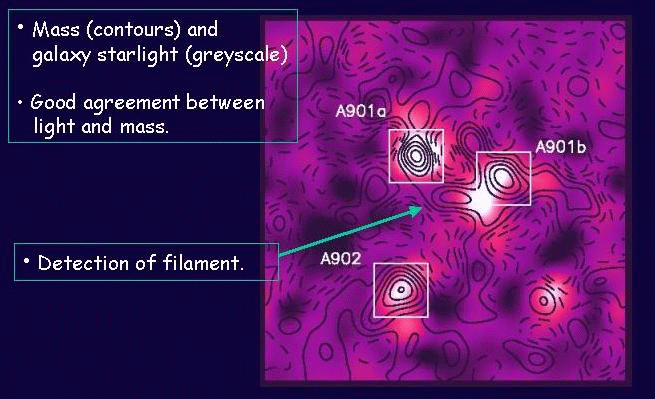- a spectrophotometric 17-filter survey -
project: Dark matter density maps from weak gravitational lensing
Mass and light in the A901/902 supercluster

project: Dark matter density maps from weak gravitational lensing
Mass and light in the A901/902 supercluster

By measuring the coherent distortion induced on faint background galaxies
(`weak shear') we use gravitational lensing techniques to reconstruct the
2D projected surface mass density of the Abell 901/902 supercluster, composed
of three rich clusters at z~0.17. The clusters themselves exhibit a range
of mass-to-light (M/L) ratios, X-ray properties, and galaxy populations.
We find that, on average, the light from the early-type galaxies traces
the dark matter fairly well, although one cluster is a notable exception
to this rule. A straightforward cross-correlation of the light from
the colour-selected early-type supercluster galaxies and the lensing mass
map reveals that a single M/L ratio is not adequate to fully describe
the mass-light relation in the supercluster. Finally, there
is evidence of inter-cluster filamentary structure, seen in both the galaxy
and dark matter distributions, and we discuss the effects of cluster-cluster
and cluster-filament interactions as a means to reconcile the disparate
descriptions of the supercluster.
Initial results from the deep R-band image and supplemental B-band image
were presented in Probing
the distribution of dark matter in the Abell 901/902 supercluster with
weak lensing (ApJ 2002, vol 568, pp 141-162). The project
will be further extended to explore mass-light correlations throughout
the entire COMBO-17 dataset.
Contact person: Meghan Gray, ROE
More information available at the Edinburgh
lensing homepage and the Bonn lensing homepage.
Back to COMBO-17 science page
Last update Nov 5, 2002, CW